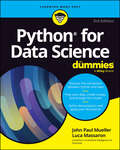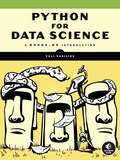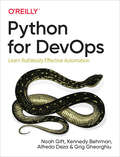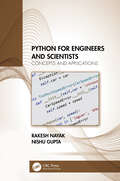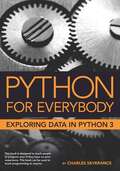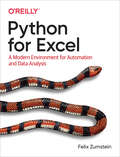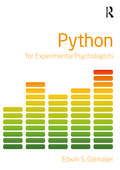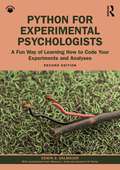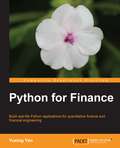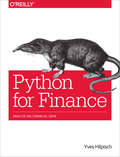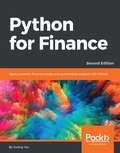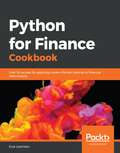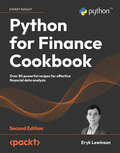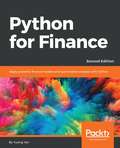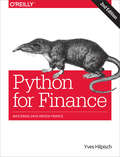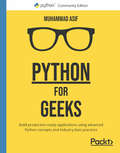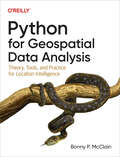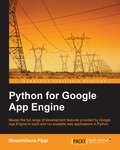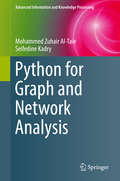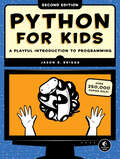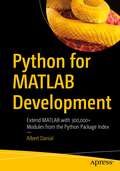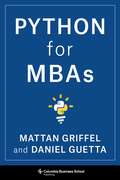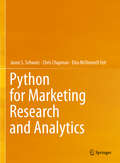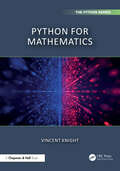- Table View
- List View
Python for Data Science For Dummies
by John Paul Mueller Luca MassaronLet Python do the heavy lifting for you as you analyze large datasets Python for Data Science For Dummies lets you get your hands dirty with data using one of the top programming languages. This beginner’s guide takes you step by step through getting started, performing data analysis, understanding datasets and example code, working with Google Colab, sampling data, and beyond. Coding your data analysis tasks will make your life easier, make you more in-demand as an employee, and open the door to valuable knowledge and insights. This new edition is updated for the latest version of Python and includes current, relevant data examples. Get a firm background in the basics of Python coding for data analysis Learn about data science careers you can pursue with Python coding skills Integrate data analysis with multimedia and graphics Manage and organize data with cloud-based relational databasesPython careers are on the rise. Grab this user-friendly Dummies guide and gain the programming skills you need to become a data pro.
Python for Data Science: A Hands-On Introduction
by Yuli VasilievA hands-on, real-world introduction to data analysis with the Python programming language, loaded with wide-ranging examples.Python is an ideal choice for accessing, manipulating, and gaining insights from data of all kinds. Python for Data Science introduces you to the Pythonic world of data analysis with a learn-by-doing approach rooted in practical examples and hands-on activities. You&’ll learn how to write Python code to obtain, transform, and analyze data, practicing state-of-the-art data processing techniques for use cases in business management, marketing, and decision support.You will discover Python&’s rich set of built-in data structures for basic operations, as well as its robust ecosystem of open-source libraries for data science, including NumPy, pandas, scikit-learn, matplotlib, and more. Examples show how to load data in various formats, how to streamline, group, and aggregate data sets, and how to create charts, maps, and other visualizations. Later chapters go in-depth with demonstrations of real-world data applications, including using location data to power a taxi service, market basket analysis to identify items commonly purchased together, and machine learning to predict stock prices.
Python for DevOps: Learn Ruthlessly Effective Automation
by Noah Gift Kennedy Behrman Alfredo Deza Grig GheorghiuMuch has changed in technology over the past decade. Data is hot, the cloud is ubiquitous, and many organizations need some form of automation. Throughout these transformations, Python has become one of the most popular languages in the world. This practical resource shows you how to use Python for everyday Linux systems administration tasks with today’s most useful DevOps tools, including Docker, Kubernetes, and Terraform.Learning how to interact and automate with Linux is essential for millions of professionals. Python makes it much easier. With this book, you’ll learn how to develop software and solve problems using containers, as well as how to monitor, instrument, load-test, and operationalize your software. Looking for effective ways to "get stuff done" in Python? This is your guide.Python foundations, including a brief introduction to the languageHow to automate text, write command-line tools, and automate the filesystemLinux utilities, package management, build systems, monitoring and instrumentation, and automated testingCloud computing, infrastructure as code, Kubernetes, and serverlessMachine learning operations and data engineering from a DevOps perspectiveBuilding, deploying, and operationalizing a machine learning project
Python for Engineers and Scientists: Concepts and Applications
by Nishu Gupta Rakesh NayakThe text focuses on the basics of Python programming fundamentals and introduction to present-day applications in technology and the upcoming state-of-art trends in a comprehensive manner. The text is based on Python 3.x and it covers the fundamentals of Python with object-oriented concepts having numerous worked-out examples. It provides a learning tool for the students of beginner level as well as for researchers of advanced level. Each chapter contains additional examples that explain the usage of methods/functions discussed in the chapter. It provides numerous programming examples along with their outputs. The book: Includes programming tips to highlight the important concepts and help readers avoid common programming errors Provides programming examples along with their outputs to ensure the correctness and help readers in mastering the art of writing efficient Python programs Contains MCQs with their answers; conceptual questions and programming questions; and solutions to some selected programming questions, for every chapter Discusses applications like time zone converter and password generators at the end Covers fundamental of Python up to object oriented concepts including regular expression The book offers a simple and lucid treatment of concepts supported with illustrations for easy understanding, provides numerous programming examples along with their outputs, and includes programming tips to highlight the important concepts. It will be a valuable resource for senior undergraduate, graduate students, and professionals in the fields of electrical engineering, electronics and communication engineering, and computer engineering.
Python for Everybody: Exploring Data Using Python 3
by Dr Charles R. SeverancePython for Everybody: Exploring Data Using Python 3
Python for Excel: A Modern Environment For Automation And Data Analysis
by Felix ZumsteinWhile Excel remains ubiquitous in the business world, recent Microsoft feedback forums are full of requests to include Python as an Excel scripting language. In fact, it's the top feature requested. What makes this combination so compelling? In this hands-on guide, Felix Zumstein--creator of xlwings, a popular open source package for automating Excel with Python--shows experienced Excel users how to integrate these two worlds efficiently.Excel has added quite a few new capabilities over the past couple of years, but its automation language, VBA, stopped evolving a long time ago. Many Excel power users have already adopted Python for daily automation tasks. This guide gets you started.Use Python without extensive programming knowledgeGet started with modern tools, including Jupyter notebooks and Visual Studio codeUse pandas to acquire, clean, and analyze data and replace typical Excel calculationsAutomate tedious tasks like consolidation of Excel workbooks and production of Excel reportsUse xlwings to build interactive Excel tools that use Python as a calculation engineConnect Excel to databases and CSV files and fetch data from the internet using Python codeUse Python as a single tool to replace VBA, Power Query, and Power Pivot
Python for Experimental Psychologists
by Edwin DalmaijerProgramming is an important part of experimental psychology and cognitive neuroscience, and Python is an ideal language for novices. It sports a very readable syntax, intuitive variable management, and a very large body of functionality that ranges from simple arithmetic to complex computing. Python for Experimental Psychologists provides researchers without prior programming experience with the knowledge they need to independently script experiments and analyses in Python. The skills it offers include: how to display stimuli on a computer screen; how to get input from peripherals (e.g. keyboard, mouse) and specialised equipment (e.g. eye trackers); how to log data; and how to control timing. In addition, it shows readers the basic principles of data analysis applied to behavioural data, and the more advanced techniques required to analyse trace data (e.g. pupil size) and gaze data. Written informally and accessibly, the book deliberately focuses on the parts of Python that are relevant to experimental psychologists and cognitive neuroscientists. It is also supported by a companion website where you will find colour versions of the figures, along with example stimuli, datasets and scripts, and a portable Windows installation of Python.
Python for Experimental Psychologists: A Fun Way of Learning How to Code Your Experiments and Analyses
by Edwin S. Dalmaijer Rebecca Hirst Jonathan PeircePython for Experimental Psychologists equips researchers who have no prior programming experience with the essential knowledge to independently script experiments and analyses in the programming language Python. This book offers an excellent introduction, whether you are an undergraduate, a PhD candidate, or an established researcher.This updated edition is on Python 3 (the most current version). It starts by teaching the fundamentals of programming in Python and then offers several chapters on scripting experiments (displaying stimuli, obtaining and logging user input, precision timing, etc.) using the popular PsychoPy package. The remainder of the book is dedicated to data analysis and includes chapters on reading/writing to text files, time series, eye tracking, data visualisation, and statistics.Access to online support material enriches the learning experience with colour figures, example stimuli, datasets, scripts, and a portable Windows installation of Python. This book assumes no prior knowledge, and its informal and accessible tone helps readers with backgrounds in experimental psychology and cognitive neuroscience to quickly understand Python. It serves as a useful resource not only for researchers in these fields but also for lecturers instructing on methodology and data analysis.Python for Experimental Psychologists demystifies programming complexities and empowers researchers to proficiently conduct experiments and analyse their results.
Python for Finance
by Yuxing YanA hands-on guide with easy-to-follow examples to help you learn about option theory, quantitative finance, financial modeling, and time series using Python. Python for Finance is perfect for graduate students, practitioners, and application developers who wish to learn how to utilize Python to handle their financial needs. Basic knowledge of Python will be helpful but knowledge of programming is necessary.
Python for Finance
by Yves HilpischThe financial industry has adopted Python at a tremendous rate recently, with some of the largest investment banks and hedge funds using it to build core trading and risk management systems. This hands-on guide helps both developers and quantitative analysts get started with Python, and guides you through the most important aspects of using Python for quantitative finance.Using practical examples through the book, author Yves Hilpisch also shows you how to develop a full-fledged framework for Monte Carlo simulation-based derivatives and risk analytics, based on a large, realistic case study. Much of the book uses interactive IPython Notebooks, with topics that include:Fundamentals: Python data structures, NumPy array handling, time series analysis with pandas, visualization with matplotlib, high performance I/O operations with PyTables, date/time information handling, and selected best practicesFinancial topics: mathematical techniques with NumPy, SciPy and SymPy such as regression and optimization; stochastics for Monte Carlo simulation, Value-at-Risk, and Credit-Value-at-Risk calculations; statistics for normality tests, mean-variance portfolio optimization, principal component analysis (PCA), and Bayesian regressionSpecial topics: performance Python for financial algorithms, such as vectorization and parallelization, integrating Python with Excel, and building financial applications based on Web technologies
Python for Finance - Second Edition
by Yuxing YanLearn and implement various Quantitative Finance concepts using the popular Python libraries About This Book • Understand the fundamentals of Python data structures and work with time-series data • Implement key concepts in quantitative finance using popular Python libraries such as NumPy, SciPy, and matplotlib • A step-by-step tutorial packed with many Python programs that will help you learn how to apply Python to finance Who This Book Is For This book assumes that the readers have some basic knowledge related to Python. However, he/she has no knowledge of quantitative finance. In addition, he/she has no knowledge about financial data. What You Will Learn • Become acquainted with Python in the first two chapters • Run CAPM, Fama-French 3-factor, and Fama-French-Carhart 4-factor models • Learn how to price a call, put, and several exotic options • Understand Monte Carlo simulation, how to write a Python program to replicate the Black-Scholes-Merton options model, and how to price a few exotic options • Understand the concept of volatility and how to test the hypothesis that volatility changes over the years • Understand the ARCH and GARCH processes and how to write related Python programs In Detail This book uses Python as its computational tool. Since Python is free, any school or organization can download and use it. This book is organized according to various finance subjects. In other words, the first edition focuses more on Python, while the second edition is truly trying to apply Python to finance. The book starts by explaining topics exclusively related to Python. Then we deal with critical parts of Python, explaining concepts such as time value of money stock and bond evaluations, capital asset pricing model, multi-factor models, time series analysis, portfolio theory, options and futures. This book will help us to learn or review the basics of quantitative finance and apply Python to solve various problems, such as estimating IBM's market risk, running a Fama-French 3-factor, 5-factor, or Fama-French-Carhart 4 factor model, estimating the VaR of a 5-stock portfolio, estimating the optimal portfolio, and constructing the efficient frontier for a 20-stock portfolio with real-world stock, and with Monte Carlo Simulation. Later, we will also learn how to replicate the famous Black-Scholes-Merton option model and how to price exotic options such as the average price call option. Style and approach This book takes a step-by-step approach in explaining the libraries and modules in Python, and how they can be used to implement various aspects of quantitative finance. Each concept is explained in depth and supplemented with code examples for better understanding.
Python for Finance Cookbook: Over 50 recipes for applying modern Python libraries to financial data analysis
by Eryk LewinsonSolve common and not-so-common financial problems using Python libraries such as NumPy, SciPy, and pandas Key Features Use powerful Python libraries such as pandas, NumPy, and SciPy to analyze your financial data Explore unique recipes for financial data analysis and processing with Python Estimate popular financial models such as CAPM and GARCH using a problem-solution approach Book Description Python is one of the most popular programming languages used in the financial industry, with a huge set of accompanying libraries. In this book, you'll cover different ways of downloading financial data and preparing it for modeling. You'll calculate popular indicators used in technical analysis, such as Bollinger Bands, MACD, RSI, and backtest automatic trading strategies. Next, you'll cover time series analysis and models, such as exponential smoothing, ARIMA, and GARCH (including multivariate specifications), before exploring the popular CAPM and the Fama-French three-factor model. You'll then discover how to optimize asset allocation and use Monte Carlo simulations for tasks such as calculating the price of American options and estimating the Value at Risk (VaR). In later chapters, you'll work through an entire data science project in the financial domain. You'll also learn how to solve the credit card fraud and default problems using advanced classifiers such as random forest, XGBoost, LightGBM, and stacked models. You'll then be able to tune the hyperparameters of the models and handle class imbalance. Finally, you'll focus on learning how to use deep learning (PyTorch) for approaching financial tasks. By the end of this book, you'll have learned how to effectively analyze financial data using a recipe-based approach. What you will learn Download and preprocess financial data from different sources Backtest the performance of automatic trading strategies in a real-world setting Estimate financial econometrics models in Python and interpret their results Use Monte Carlo simulations for a variety of tasks such as derivatives valuation and risk assessment Improve the performance of financial models with the latest Python libraries Apply machine learning and deep learning techniques to solve different financial problems Understand the different approaches used to model financial time series data Who this book is for This book is for financial analysts, data analysts, and Python developers who want to learn how to implement a broad range of tasks in the finance domain. Data scientists looking to devise intelligent financial strategies to perform efficient financial analysis will also find this book useful. Working knowledge of the Python programming language is mandatory to grasp the concepts covered in the book effectively.
Python for Finance Cookbook: Over 80 powerful recipes for effective financial data analysis, 2nd Edition
by Eryk LewinsonUse modern Python libraries such as pandas, NumPy, and scikit-learn and popular machine learning and deep learning methods to solve financial modeling problemsPurchase of the print or Kindle book includes a free eBook in the PDF formatKey FeaturesExplore unique recipes for financial data processing and analysis with PythonApply classical and machine learning approaches to financial time series analysisCalculate various technical analysis indicators and backtesting backtest trading strategiesBook DescriptionPython is one of the most popular programming languages in the financial industry, with a huge collection of accompanying libraries. In this new edition of the Python for Finance Cookbook, you will explore classical quantitative finance approaches to data modeling, such as GARCH, CAPM, factor models, as well as modern machine learning and deep learning solutions.You will use popular Python libraries that, in a few lines of code, provide the means to quickly process, analyze, and draw conclusions from financial data. In this new edition, more emphasis was put on exploratory data analysis to help you visualize and better understand financial data. While doing so, you will also learn how to use Streamlit to create elegant, interactive web applications to present the results of technical analyses.Using the recipes in this book, you will become proficient in financial data analysis, be it for personal or professional projects. You will also understand which potential issues to expect with such analyses and, more importantly, how to overcome them.What you will learnPreprocess, analyze, and visualize financial dataExplore time series modeling with statistical (exponential smoothing, ARIMA) and machine learning modelsUncover advanced time series forecasting algorithms such as Meta's ProphetUse Monte Carlo simulations for derivatives valuation and risk assessmentExplore volatility modeling using univariate and multivariate GARCH modelsInvestigate various approaches to asset allocationLearn how to approach ML-projects using an example of default predictionExplore modern deep learning models such as Google's TabNet, Amazon's DeepAR and NeuralProphetWho this book is forThis book is intended for financial analysts, data analysts and scientists, and Python developers with a familiarity with financial concepts. You'll learn how to correctly use advanced approaches for analysis, avoid potential pitfalls and common mistakes, and reach correct conclusions for a broad range of finance problems.Working knowledge of the Python programming language (particularly libraries such as pandas and NumPy) is necessary.
Python for Finance Second Edition
by Yuxing YanA hands-on guide with easy-to-follow examples to help you learn about option theory, quantitative finance, financial modeling, and time series using Python. Python for Finance is perfect for graduate students, practitioners, and application developers who wish to learn how to utilize Python to handle their financial needs. Basic knowledge of Python will be helpful but knowledge of programming is necessary.
Python for Finance: Mastering Data-Driven Finance
by Yves J. HilpischThe financial industry has recently adopted Python at a tremendous rate, with some of the largest investment banks and hedge funds using it to build core trading and risk management systems. Updated for Python 3, the second edition of this hands-on book helps you get started with the language, guiding developers and quantitative analysts through Python libraries and tools for building financial applications and interactive financial analytics.Using practical examples throughout the book, author Yves Hilpisch also shows you how to develop a full-fledged framework for Monte Carlo simulation-based derivatives and risk analytics, based on a large, realistic case study. Much of the book uses interactive IPython Notebooks.
Python for Geeks: Build production-ready applications using advanced Python concepts and industry best practices
by Muhammad AsifTake your Python skills to the next level to develop scalable, real-world applications for local as well as cloud deploymentKey FeaturesAll code examples have been tested with Python 3.7 and Python 3.8 and are expected to work with any future 3.x releaseLearn how to build modular and object-oriented applications in PythonDiscover how to use advanced Python techniques for the cloud and clustersBook DescriptionPython is a multipurpose language that can be used for multiple use cases. Python for Geeks will teach you how to advance in your career with the help of expert tips and tricks.You'll start by exploring the different ways of using Python optimally, both from the design and implementation point of view. Next, you'll understand the life cycle of a large-scale Python project. As you advance, you'll focus on different ways of creating an elegant design by modularizing a Python project and learn best practices and design patterns for using Python. You'll also discover how to scale out Python beyond a single thread and how to implement multiprocessing and multithreading in Python. In addition to this, you'll understand how you can not only use Python to deploy on a single machine but also use clusters in private as well as in public cloud computing environments. You'll then explore data processing techniques, focus on reusable, scalable data pipelines, and learn how to use these advanced techniques for network automation, serverless functions, and machine learning. Finally, you'll focus on strategizing web development design using the techniques and best practices covered in the book.By the end of this Python book, you'll be able to do some serious Python programming for large-scale complex projects.What you will learnUnderstand how to design and manage complex Python projectsStrategize test-driven development (TDD) in PythonExplore multithreading and multiprogramming in PythonUse Python for data processing with Apache Spark and Google Cloud Platform (GCP)Deploy serverless programs on public clouds such as GCPUse Python to build web applications and application programming interfacesApply Python for network automation and serverless functionsGet to grips with Python for data analysis and machine learningWho this book is forThis book is for intermediate-level Python developers in any field who are looking to build their skills to develop and manage large-scale complex projects. Developers who want to create reusable modules and Python libraries and cloud developers building applications for cloud deployment will also find this book useful. Prior experience with Python will help you get the most out of this book.
Python for Geospatial Data Analysis: Theory, Tools, and Practice for Location Intelligence
by Bonny P. McClainIn spatial data science, things in closer proximity to one another likely have more in common than things that are farther apart. With this practical book, geospatial professionals, data scientists, business analysts, geographers, geologists, and others familiar with data analysis and visualization will learn the fundamentals of spatial data analysis to gain a deeper understanding of their data questions.Author Bonny P. McClain demonstrates why detecting and quantifying patterns in geospatial data is vital. Both proprietary and open source platforms allow you to process and visualize spatial information. This book is for people familiar with data analysis or visualization who are eager to explore geospatial integration with Python.This book helps you:Understand the importance of applying spatial relationships in data scienceSelect and apply data layering of both raster and vector graphicsApply location data to leverage spatial analyticsDesign informative and accurate mapsAutomate geographic data with Python scriptsExplore Python packages for additional functionalityWork with atypical data types such as polygons, shape files, and projectionsUnderstand the graphical syntax of spatial data science to stimulate curiosity
Python for Google App Engine
by Massimiliano PippiIf you are a Python developer, whether you have experience in web applications development or not, and want to rapidly deploy a scalable backend service or a modern web application on Google App Engine, then this book is for you.
Python for Graph and Network Analysis
by Seifedine Kadry Mohammed Zuhair Al-TaieThis research monograph provides the means to learn the theory and practice of graph and network analysis using the Python programming language. The social network analysis techniques, included, will help readers to efficiently analyze social data from Twitter, Facebook, LiveJournal, GitHub and many others at three levels of depth: ego, group, and community. They will be able to analyse militant and revolutionary networks and candidate networks during elections. For instance, they will learn how the Ebola virus spread through communities. Practically, the book is suitable for courses on social network analysis in all disciplines that use social methodology. In the study of social networks, social network analysis makes an interesting interdisciplinary research area, where computer scientists and sociologists bring their competence to a level that will enable them to meet the challenges of this fast-developing field. Computer scientists have the knowledge to parse and process data while sociologists have the experience that is required for efficient data editing and interpretation. Social network analysis has successfully been applied in different fields such as health, cyber security, business, animal social networks, information retrieval, and communications.
Python for Kids, 2nd Edition: A Playful Introduction to Programming
by Jason R. BriggsThe second edition of the best-selling Python for Kids—which brings you (and your parents) into the world of programming—has been completely updated to use the latest version of Python, along with tons of new projects!Python is a powerful, expressive programming language that&’s easy to learn and fun to use! But books about learning to program in Python can be dull and gray—and that&’s no fun for anyone.Python for Kids brings Python to life and brings kids (and their parents) into the wonderful world of programming. Author Jason R. Briggs guides readers through the basics, experimenting with unique (and often hilarious) example programs that feature ravenous monsters, secret agents, thieving ravens, and more. New terms are defined; code is colored, dissected, and explained; and quirky, full-color illustrations keep things fun and engaging throughout.Chapters end with programming puzzles designed to stretch the brain and strengthen understanding. By the end of the book, young readers will have programmed two complete games: a clone of the famous Pong, and &“Mr. Stick Man Races for the Exit&”—a platform game with jumps, animation, and much more.This second edition has been completely updated and revised to reflect the latest Python version and programming practices, with new puzzles to inspire readers to take their code farther than ever before. Why should serious adults have all the fun? Python for Kids is the ticket into the amazing world of computer programming.
Python for Kids: A Playful Introduction To Programming
by Jason BriggsPython is a powerful, expressive programming language that’s easy to learn and fun to use! But books about learning to program in Python can be kind of dull, gray, and boring, and that’s no fun for anyone.Python for Kids brings Python to life and brings you (and your parents) into the world of programming. The ever-patient Jason R. Briggs will guide you through the basics as you experiment with unique (and often hilarious) example programs that feature ravenous monsters, secret agents, thieving ravens, and more. New terms are defined; code is colored, dissected, and explained; and quirky, full-color illustrations keep things on the lighter side.Chapters end with programming puzzles designed to stretch your brain and strengthen your understanding. By the end of the book you’ll have programmed two complete games: a clone of the famous Pong and "Mr. Stick Man Races for the Exit"—a platform game with jumps, animation, and much more.As you strike out on your programming adventure, you’ll learn how to:–Use fundamental data structures like lists, tuples, and maps–Organize and reuse your code with functions and modules–Use control structures like loops and conditional statements–Draw shapes and patterns with Python’s turtle module–Create games, animations, and other graphical wonders with tkinterWhy should serious adults have all the fun? Python for Kids is your ticket into the amazing world of computer programming.For kids ages 10+ (and their parents)The code in this book runs on almost anything: Windows, Mac, Linux, even an OLPC laptop or Raspberry Pi!
Python for MATLAB Development: Extend MATLAB with 300,000+ Modules from the Python Package Index
by Albert DanialMATLAB can run Python code!Python for MATLAB Development shows you how to enhance MATLAB with Python solutions to a vast array of computational problems in science, engineering, optimization, statistics, finance, and simulation. It is three books in one:A thorough Python tutorial that leverages your existing MATLAB knowledge with a comprehensive collection of MATLAB/Python equivalent expressionsA reference guide to setting up and managing a Python environment that integrates cleanly with MATLABA collection of recipes that demonstrate Python solutions invoked directly from MATLAB This book shows how to call Python functions to enhance MATLAB's capabilities. Specifically, you'll see how Python helps MATLAB:Run faster with numbaDistribute work to a compute cluster with daskFind symbolic solutions to integrals, derivatives, and series summations with SymPyOverlay data on maps with CartopySolve mixed-integer linear programming problems with PuLPInteract with Redis via pyredis, PostgreSQL via psycopg2, and MongoDB via pymongoRead and write file formats that are not natively understood by MATLAB, such as SQLite, YAML, and iniWho This Book Is ForMATLAB developers who are new to Python and other developers with some prior experience with MATLAB, R, IDL, or Mathematica.
Python for MBAs
by Mattan Griffel Daniel GuettaFrom the ads that track us to the maps that guide us, the twenty-first century runs on code. The business world is no different. Programming has become one of the fastest-growing topics at business schools around the world. An increasing number of MBAs are choosing to pursue careers in tech. For them and other professionals, having some basic coding knowledge is a must.This book is an introduction to programming with Python for MBA students and others in business positions who need a crash course. One of the most popular programming languages, Python is used for tasks such as building and running websites, data analysis, machine learning, and natural-language processing. Drawing on years of experience providing instruction in this material at Columbia Business School as well as extensive backgrounds in technology, entrepreneurship, and consulting, Mattan Griffel and Daniel Guetta teach the basics of programming from scratch. Beginning with fundamentals such as variables, strings, lists, and functions, they build up to data analytics and practical ways to derive value from large and complex datasets. They focus on business use cases throughout, using the real-world example of a major restaurant chain to offer a concrete look at what Python can do. Written for business students with no previous coding experience and those in business roles that include coding or working with coding teams, Python for MBAs is an indispensable introduction to a versatile and powerful programming language.
Python for Marketing Research and Analytics
by Chris Chapman Elea McDonnell Feit Jason S. SchwarzThis book provides an introduction to quantitative marketing with Python. The book presents a hands-on approach to using Python for real marketing questions, organized by key topic areas. Following the Python scientific computing movement toward reproducible research, the book presents all analyses in Colab notebooks, which integrate code, figures, tables, and annotation in a single file. The code notebooks for each chapter may be copied, adapted, and reused in one's own analyses. The book also introduces the usage of machine learning predictive models using the Python sklearn package in the context of marketing research. This book is designed for three groups of readers: experienced marketing researchers who wish to learn to program in Python, coming from tools and languages such as R, SAS, or SPSS; analysts or students who already program in Python and wish to learn about marketing applications; and undergraduate or graduate marketing students with little or no programming background. It presumes only an introductory level of familiarity with formal statistics and contains a minimum of mathematics.
Python for Mathematics (Chapman & Hall/CRC The Python Series)
by Vincent KnightPython for Mathematics introduces readers to effective methods for doing mathematics using the Python programming language. Most programming texts introduce readers to the building blocks of programming and build up to using more sophisticated tools for a specific purpose, like doing particular mathematical tasks. This is akin to teaching someone how to forge metal so as to make a nail, and then slowly working up to using sophisticated power tools so as to actually build something. This book does things in a different way, by first getting readers to begin using and understanding the tools that are going to be helpful to them as mathematicians, and only then moving onto the granular details. In this way, the practical application of the tools can aid in the understanding of the theory.Features· Complete with engaging, practical exercises· Many useful and detailed coding examples· Suitable for undergraduates in mathematics, and other quantitative sciences· Empowers readers to design and create their own Python tools.
